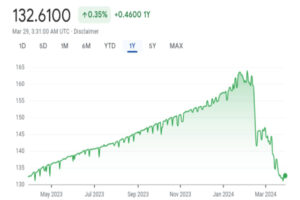Financial literacy is not taught in schools, but ordinary folks are encouraged to make financial investments for future financial security. How are they supposed to know what they are doing in the financial market? Knowing the different stages of the economic cycle can make the difference between winning and losing in the financial market.
12 O’clock: This is boom time, and it is characterized by a real estate and stock market boom. The economy has been doing well. Blue chip companies have been turning record profits. Commodity prices are rising. Credit is cheap, life is good, and the investment atmosphere is euphoric. Exotic investments promising mind-boggling returns spring up all over. Am I talking about bitcoin and the many other cryptocurrencies? What about pyramid schemes of yesteryears? These are the times we are living in.
1 O’clock: This is slow down time. Policymakers are alarmed by the excesses in the economy. There is too much prosperity and the strong purchasing power of consumers is overheating the economy. Inflation becomes a problem and policymakers slam on the brakes. They begin to raise interest rates. Stock and bond markets begin to decline. Have you heard that central banks have been raising interest rates?
2 O’clock: Is slump time. The inflation problem persists. Policymakers raise Interest rates even more. Business activity slows down because credit is becoming expensive. Stock prices decline together with the value of bonds. Gold and other precious metals that have been trading sideways for years register initial gains. Have you heard that a recession or a depression is on the horizon?
3 O’clock: Here is where we start seeing corporate failures. Corporations that are sustained by high levels of debt succumb to high interest rates, and the declining purchasing power of consumers. Commodity prices decline because of a general slowdown in manufacturing and consumption. Foreign exchange rates become volatile. Easy money disappears. Smart money pivots towards gold and other precious metals and away from stocks, bonds and real estate. Prices of gold and other precious metals soar. The good high life comes to an end.
4 O’clock: Corporate failures continue. Many Jobs are lost. Foreign exchange reserves decline. Currencies depreciate. More smart money piles into Gold and other precious metals. This asset class breaks records to reach all time highs.
5 O’clock: Is gloom time. All remaining traces of the high life and prosperity disappear. Lenders take huge losses from credit defaults and they freeze lending. Only strong corporations survive. Money becomes scarce. Currencies depreciate further. The global economy slows down to a crawl. Gold and other precious metals begin to trade in multiples of the previous cycle’s highs as more smart money piles in.
6 O’clock: Real estate gives, and property prices tumble. Corporate failures climax. Commercial banks are hit hardest and many collapse as real estate and other assets they hold as collateral lose value and undermine debt recovery efforts. There is massive depreciation of global currencies. The last traces of smart money still holding out in other asset classes pivots to gold and other precious metals and prices soar to several multiples of the previous cycle’s highs.
7 O’clock: All bubbles in the global economy have popped. Bonds, commodities, real estate and the stock market have all corrected to fair value. Some countries experience a total collapse of their national currency. The Inflation problem transitions to a depression problem. Monetary policymakers feel the pressure to jump start the global economy and they begin to lower interest rates. Gold and other precious metals investors make a fortune.
8 O’clock: The economy responds to lower interest rates by recovering unevenly. The stock market begins to rise. Foreign exchange rates begin to stabilize. Prices of gold and other precious metals peak as dumb money begins to pile in.
9 O’clock: Interest rates are lowered further and the economy responds by going into general recovery. Employment picks up. Commodity prices begin to rise. Prices of gold and other precious metals begin to crest. Smart money begins to pivot back to stocks, bonds and real estate.
10 O’clock: This is a strong recovery time. Credit becomes cheap again. Lenders lower interest rates as they compete for market share. Real estate prices begin to rise. Foreign exchange reserves increase and the good life makes a comeback. Prices of gold and other precious metals plateau.
11 O’clock: The economy is in an upbeat mood. Employment reaches new highs. Bond, stock, real estate and commodities markets enter into a strong bull market phase. The politicians and policymakers who find themselves at the helm at this time chest thump their efforts. The media complements the chest thumping. Blue chip companies start returning record profits. Goods and services become expensive, but consumers have more than enough money to buy them. The good life returns in full swing and people are encouraged to spend. Prices of gold and other precious metals retreat from all time highs but remain several multiples higher than the previous cycle’s highest prices. The economy then goes back to 12 o’clock and the cycle repeats.
Historically, this cycle lasted between eight to ten years. The last global economic boom popped in 2008. The popping of the current global economic boom is way overdue. The printing of money by the main central banks of the world helped to kick the can farther down the road. As an investor, you made money if you rebalanced your portfolio to flow with the economic cycle and lost money if you went against it.
Having the benefit of this hindsight while investing is the key to winning in the financial markets. If you are too busy, or if this subject is not your cup of tea, find a good financial adviser and let him help you walk your portfolio through the different stages of the economic cycle.






